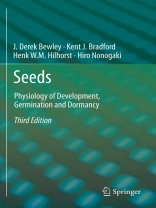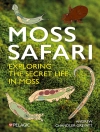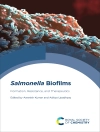This updated and much revised third edition of Seeds: Physiology of Development, Germination and Dormancy provides a thorough overview of seed biology and incorporates much of the progress that has been made during the past fifteen years. With an emphasis on placing information in the context of the seed, this new edition includes recent advances in the areas of molecular biology of development and germination, as well as fresh insights into dormancy, ecophysiology, desiccation tolerance, and longevity. Authored by preeminent authorities in the field, this book is an invaluable resource for researchers, teachers, and students interested in the diverse aspects of seed biology.
Jadual kandungan
Chapter 1Structure and Composition1.1. Introduction1.2. Seed structure1.2.1. Embryo1.2.2. Non-embryonic storage tissues1.2.3. Testa – seed coat1.3. Seed storage reserves1.3.1. Carbohydrates1.3.2. Oils (Neutral lipids)1.3.3. Proteins1.3.4. Phytin1.3.5. Other constituents Chapter 2Development and Maturation2.1. Fertilization2.2. Embryogeny and storage tissue formation 2.2.1. Embryonic tissues 2.2.2. Endosperm 2.2.3. Testa (seed coat)2.3. Regulation of seed development 2.3.1. Plant hormones 2.3.2. Embryo polarity and patterning 2.3.3. ABA content and sensitivity to ABA during development 2.3.4. Regulation of the seed maturation program 2.3.5. Epigenetic control of endosperm development 2.3.6. Testa development and its interaction with the endosperm and embryo 2.3.7. Somatic embryogenesis and apomixis2.4. Germinability during development 2.4.1. Ability to germinate during development 2.4.2. Precocious germination: Vivipary and preharvest sprouting 2.4.3. Role of preharvest drying in development of germinability2.5. Maturation drying and the ‘switch’ to germination 2.5.1. The acquisition of desiccation tolerance 2.5.2. Protective mechanisms associated with drying 2.5.2.1. Membranes, proteins and water replacement 2.5.2.2. Gene expression and protein synthesis 2.5.2.3. Other changes in metabolism associated with drying 2.5.3. Gene expression changes upon rehydration2.6. Late maturation events and seed drying 2.6.1. Physiological maturity versus harvest maturity 2.6.2. Seed development and seed quality 2.6.3. Maturation drying and biophysical aspects of dry seeds Chapter 3Synthesis of Storage Reserves3.1. Assimilates for grain and seed filling 3.1.1. Source of nutrients for storage reserve synthesis 3.1.2. Import of nutrients into the developing seed 3.1.3. Factors affecting seed production and quality3.2. Deposition of reserves within storage tissues 3.2.1. Starch synthesis 3.2.1.1. Uses and modifications of starch 3.2.2. Synthesis of polymeric carbohydrates other than starch 3.2.3. Oil (triacylglycerol) synthesis 3.2.3.1. Uses and modifications of fatty acids 3.2.4. Storage protein synthesis 3.2.4.1. Synthesis, processing and deposition of storage proteins 3.2.4.2. Uses and modifications of storage proteins 3.2.4.3. Regulation of storage protein synthesis 3.2.5. Phytin synthesis 3.2.6. Modifications of non-storage compounds to improve nutritional quality Chapter 4Germination4.1. Seed germination – definition and general features4.2. Measurement of germination4.3. Imbibition 4.3.1. Uptake of water from the soil 4.3.2. Phase I, imbibition and imbibitional damage 4.3.3. Phase II, the lag phase 4.3.4. Phase III, completion of germination 4.3.5. Kinetics of imbibition4.4. Respiration – oxygen consumption and mitochondrial development 4.4.1. Pathways and products 4.4.2. Respiration during imbibition and germination 4.4.3. Mitochondrial development and oxidative phosphorylation 4.4.4. Respiration under low oxygen conditions4.5. RNA and protein synthesis 4.5.1. Transcriptomes of dry and germinating seeds 4.5.2. Proteomes of germinating seeds4.6. The completion of germination 4.6.1. Embryo growth potential verses enclosing tissue constraints in radicle emergence 4.6.2. DNA synthesis and cell division (cell cycle)4.7. Priming and the enhancement of germination Chapter 5Mobilization of Stored Reserves5.1. Seedling growth patterns5.2. Mobilization of stored reserves5.3. Stored oligosaccharide catabolism5.4. Pathways of starch catabolism 5.4.1. Synthesis of sucrose5.5. Mobilization of stored starch in cereal grains 5.5.1. Synthesis and release of -amylase and other hydrolases from the aleurone layer 5.5.2. Starch breakdown and the fate of the products of hydrolysis 5.5.3. Hormonal control of starch mobilization 5.5.4. Programmed cell death (PCD) of the aleurone layer and other tissues5.6. Mobilization of stored carbohydrate reserves in dicots 5.6.1. Starch-storing non-endospermic legumes 5.6.2. Hemicellulose-storing endospermic legumes 5.6.3. Hemicellulose-containing seeds other than legumes5.7. Stored triacylglycerol (TAG) mobilization 5.7.1. Mobilization of TAGs from oil bodies 5.7.2. Role and formation of the glyoxysome 5.7.3. Utilization of the products of TAG catabolism5.8. Storage protein mobilization 5.8.1. Protein mobilization during germination 5.8.2. Protein mobilization following germination of cereals 5.8.2.1. Uptake of amino acids and peptides into the embryo 5.8.3. Protein mobilization following germination of dicots5.8.4. Protease inhibitors5.8.5. Utilization of liberated amino acids in dicot seedlings5.9. Phytin mobilization5.10. Control of reserve mobilization in dicots 5.10.1. Regulation in endospermic dicots 5.10.2. Regulation in non-endospermic dicots 5.10.2.1. Mode of regulation by the axis Chapter 6Dormancy and the Control of Germination6.1. Dormancy – its biological role 6.2. Categories of dormancy6.3. Mechanisms of dormancy 6.3.1. Blocks to germination within the embryo 6.3.1.1. Undifferentiated embryo 6.3.1.2. Immature embryo 6.3.1.3. Chemical inhibitors 6.3.1.4. Regulatory and metabolic constraints 6.3.2. Blocks to germination by the covering layers 6.3.2.1. Interference with water uptake 6.3.2.2. Interference with gas exchange 6.4.2.3. Prevention of exit of inhibitors from the embryo 6.4.2.4. Mechanical restraint6.4. Embryonic inadequacy – the causes 6.4.1. Energy metabolism of dormant seeds6.4.2. Genetic aspects of dormancy6.5. The environment in dormancy perception 6.6. The release from dormancy6.6.1. Perception, signaling and role of hormones with respect to dormancy and germination 6.6.1.1. Regulation by ABA 6.6.1.2. Regulation by GA 6.6.1.3. Regulation by ethylene and brassinosteroids 6.6.1.4. ABA/GA balance and hormonal cross-talk in the regulation of dormancy6.6.2. After-ripening6.6.3. Low temperatures (chilling)6.6.4. Other effects of temperature on dormancy6.6.5. Light 6.6.5.1. Phytochrome: action spectra 6.6.5.2. Phytochrome: photoequilibria 6.6.5.3. Phytochrome: multiple forms 6.6.5.4. Phytochrome: downstream signaling 6.6.6. Dormancy release of seeds with impermeable coats 6.6.7. Breaking of dormancy by chemicals 6.6.7.1. Breaking of dormancy by nitrate 6.6.7.2. Breaking of dormancy by nitric oxide 6.6.7.3. Breaking of dormancy by smoke Chapter7Environmental Regulation of Dormancy and Germination7.1. Seed dispersal and burial 7.1.1. The soil seed bank7.2. Environmental control of germination 7.2.1. Water 7.2.1.1. Hydrotime model of germination 7.2.1.2. Hydrotime and dormancy 7.2.1.3. Ecological applications of the hydrotime model 7.2.2. Temperature7.2.2.1. Cardinal temperatures for seed germination 7.2.2.2. Thermal time models 7.2.2.3. Temperature and water interactions: hydrothermal time models 7.2.3. Light 7.2.3.1. Phytochrome responses 7.2.4. Nitrate 7.2.5. Oxygen and other gases 7.2.6. Other chemicals7.3. Secondary dormancy and seasonal variation 7.3.1. Dormancy cycling 7.3.2. Dormancy cycling: mechanisms and modeling7.4. Influences of plant life cycle, distribution and origin on germination 7.4.1. Plant distribution 7.4.2. Seasonal and flowering interactions affecting dormancy Chapter 8Longevity, Storage and Deterioration8.1. Ancient seeds8.2. Longevity of seeds in storage 8.2.1. Patterns of seed viability loss during storage 8.2.2. Temperature, moisture content and seed longevity 8.2.3. Other factors that affect seed viability during storage8.3. Seed storage and conservation 8.3.1. Short-term storage 8.3.2. Long-term genetic conservation—ex situ seed gene banks 8.3.3. Long-term genetic conservation—in situ Centers of Diversity8.4. Mechanisms and consequences of deterioration in seeds 8.4.1. Deterioration mechanisms in stored seeds 8.4.2. Consequences of storage on germination8.5. Mechanisms of after-ripening in dry seeds8.6. Recalcitrant seeds
Mengenai Pengarang
J. Derek Bewley, Ph D, DSc Department of Molecular and Cellular Biology, University of Guelph, Guelph, Ontario, CANKent J. Bradford, Ph DDepartment of Plant Sciences, Seed Biotechnology Center, University of California, Davis, CA, USAHenk W.M. Hilhorst, Ph DWageningen Seed Laboratory, Laboratory of Plant Physiology, Wageningen University, Wageningen, Netherlands Hiroyuki Nonogaki, Ph DDepartment of Horticulture, Oregon State University, Corvallis, OR, USA











